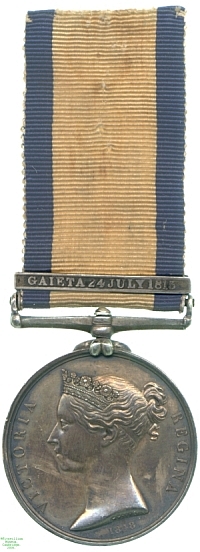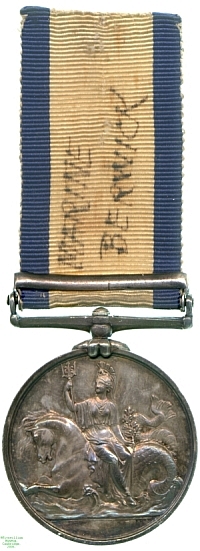
Obverse, a bust of Queen Victoria

Reverse, Britannia with a trident seated sideways on a seahorse

Obverse, a bust of Queen Victoria |

Reverse, Britannia with a trident seated sideways on a seahorse |
Just as in 1848 the extensive land campaigns of the Napoleonic Wars and the other conflicts of the pre-Victorian era were recognised by the issue of the Miltary General Service Medal, those serving in the Navy at the time were recognised with the Naval General Service Medal. As with the Army equivalent and the East India Company's related award, many of the battles for which the medal was awarded had been fought so long ago that few if any claimants survived.
In addition, bars were awarded for many actions whose significance and size were, despite the heroism displayed by those involved, relatively minor. The result was that many of the bars were issued in tiny numbers, with some combinations all but unique, and the medals command a very high price among collectors because of this rarity and individuality. This in turn, along with the manufacture in most cases of more bars than were eventually issued, has led to the `improvement' of many common awards where recipients' names are shared with those present at `rarer' battles. The medal also shares with the Military General Service and Army of India Medals the oddity that Queen Victoria, whose portrait they bear, was not the ruler under whom the battles for which it was awarded were fought.
The return of Emperor Napoleon I from exile in St Helena in 1815 galvanised Europe into a fresh spasm of warfare known as the Hundred Days. Although pitted against Britain, Russia, Austria, Sweden, Prussia, the Netherlands and various German states, France was not completely alone, as Napoleon's former general Joachim Murat, since 1812 King of Naples, threw in his lot with the returned Napoleon and declared war on Austria in March 1815. His population signally failed to rally to his call and the Austrians routed his armies within two months, and restored Bourbon rule in Naples on May 23. Some parts of the Kingdom of Naples resisted longer, however, and one of these was the city of Gaeta, which fell to the Austrians only after a prolonged siege.
Joining with the Austrian attack were two vessels of the Royal Navy, the 74-gun third-rate HMS Berwick and the 84-gun HMS Malta, ex-French Guillaume Tell. The two battleships bombarded the city for three days from 17 July, and it finally capitulated on 8 August, so the date chosen by the Admiralty for the relevant bar to the NGSM is slightly odd. 89 were awarded in 1848.
This example is inscribed to Thomas Cook, of the Royal Marines contingent aboard HMS Berwick. The presence of such a man aboard the vessel at this time is verified, and the Medals Roll confirms the award of the piece to him, but also shows that other men of the same name were awarded the commoner bars for Syria and other engagements. This makes it impossible to be certain that this piece is not one of the commoner issues retooled with a rarer bar, but it is certainly possible that this is genuinely the Berwick crewman's medal. Lester Watson purchased it late in his life, from the London dealer Seaby in 1937; it had previously been sold at Sotheby's in November 1912.